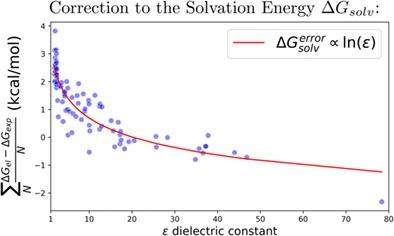当前位置:
X-MOL 学术
›
J. Comput. Chem.
›
论文详情
Our official English website, www.x-mol.net, welcomes your
feedback! (Note: you will need to create a separate account there.)
Towards a transferable nonelectrostatic model for continuum solvation: The electrostatic and nonelectrostatic energy correction model
Journal of Computational Chemistry ( IF 3.4 ) Pub Date : 2022-06-09 , DOI: 10.1002/jcc.26944 Dario Vassetti 1 , Frédéric Labat 1
Journal of Computational Chemistry ( IF 3.4 ) Pub Date : 2022-06-09 , DOI: 10.1002/jcc.26944 Dario Vassetti 1 , Frédéric Labat 1
Affiliation

|
In this work, we introduce an electrostatic and non-electrostatic (ENE) correction to the solvation energy based on the Solvent-Accessible Surface Area (SASA) of the solute and the solvent static dielectric constant. The proposed correction was developed for neutral solutes in non-aqueous solvents, considering three different implicit solvation models based on a Self-Consistent Reaction Field treatment of solute-solvent mutual polarization using an Apparent Surface Charge formalism, namely the Integral Equation Formalism of the Polarizable Continuum Model using a continuous surface charge scheme (PCM), the Solvation Model based on solute electron density (SMD), and the generalized Finite-Difference Poisson-Boltzmann (FDPB) model. The proposed correction was parametrized on a diverse training set of 4980 solvation data from the Solv@tum database of experimental solvation energies, and validated on the non-aqueous subset of the MNSOL database comprising 2140 solvation energies. The performances of the proposed ENE models with minimal and extended parameters formulations have been analyzed and the latter variant has been further compared to the widely used Cavity, Dispersion, and Solvent structural effects (CDS) non-electrostatic model originally developed for the SMx family of implicit solvation models. Overall, a very good agreement between the computed solvation energies with the ENE correction and the reference experimental data has been found on both the training and test sets for all continuum solvation models considered. Furthermore, results for the ENE correction are on par with the reference CDS non-electrostatic model for both SMD and FDPB electrostatics, but with the advantage of using a lower number of parameters and thus an improved transferability between different electrostatics treatments.
中文翻译:

迈向连续溶剂化的可转移非静电模型:静电和非静电能量校正模型
在这项工作中,我们基于溶质的溶剂可及表面积 (SASA) 和溶剂静态介电常数对溶剂化能进行了静电和非静电 (ENE) 校正。所提出的校正是针对非水溶剂中的中性溶质开发的,考虑了三种不同的隐式溶剂化模型,这些模型基于使用表观表面电荷形式的溶质-溶剂互极化的自洽反应场处理,即极化的积分方程形式使用连续表面电荷方案 (PCM) 的连续体模型、基于溶质电子密度 (SMD) 的溶剂化模型和广义有限差分泊松-玻尔兹曼 (FDPB) 模型。建议的校正在来自 Solv@tum 实验溶剂化能量数据库的 4980 个溶剂化数据的不同训练集上参数化,并在 MNSOL 数据库的非水子集(包括 2140 个溶剂化能量)上进行了验证。已经分析了所提出的具有最小和扩展参数公式的 ENE 模型的性能,并将后一种变体与最初为 SMx 系列开发的广泛使用的腔、分散和溶剂结构效应 (CDS) 非静电模型进行了进一步比较隐式求解模型。总体而言,在所考虑的所有连续溶剂化模型的训练集和测试集上,计算出的具有 ENE 校正的溶剂化能量与参考实验数据之间的一致性非常好。此外,
更新日期:2022-06-09
中文翻译:

迈向连续溶剂化的可转移非静电模型:静电和非静电能量校正模型
在这项工作中,我们基于溶质的溶剂可及表面积 (SASA) 和溶剂静态介电常数对溶剂化能进行了静电和非静电 (ENE) 校正。所提出的校正是针对非水溶剂中的中性溶质开发的,考虑了三种不同的隐式溶剂化模型,这些模型基于使用表观表面电荷形式的溶质-溶剂互极化的自洽反应场处理,即极化的积分方程形式使用连续表面电荷方案 (PCM) 的连续体模型、基于溶质电子密度 (SMD) 的溶剂化模型和广义有限差分泊松-玻尔兹曼 (FDPB) 模型。建议的校正在来自 Solv@tum 实验溶剂化能量数据库的 4980 个溶剂化数据的不同训练集上参数化,并在 MNSOL 数据库的非水子集(包括 2140 个溶剂化能量)上进行了验证。已经分析了所提出的具有最小和扩展参数公式的 ENE 模型的性能,并将后一种变体与最初为 SMx 系列开发的广泛使用的腔、分散和溶剂结构效应 (CDS) 非静电模型进行了进一步比较隐式求解模型。总体而言,在所考虑的所有连续溶剂化模型的训练集和测试集上,计算出的具有 ENE 校正的溶剂化能量与参考实验数据之间的一致性非常好。此外,











































 京公网安备 11010802027423号
京公网安备 11010802027423号